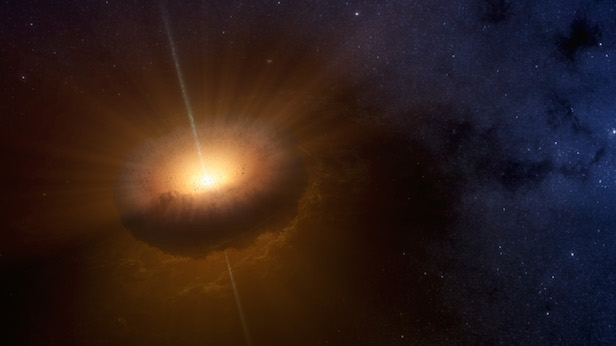New models explain how planets are formed from gas and dust
By simulating the movement of dust as it moves through gas shows how larger clumps of material form, eventually leading to the formation of planets

4.6 billion years ago, the Solar System was formed from a disk of gas and dust. Image credit: NASA/JPL-Caltech
In theoretical research that could explain everything from planet formation to outflows from stars, to even the settling of volcanic ash, California Institute of Technology (Caltech) researchers in California, United States, have discovered a new mechanism to explain how the act of dust moving through gas leads to clumps of dust. While dust clumps were already known to play a role in seeding new planets and many other systems in space and on Earth, how the clumps formed was unknown until now.
Phil Hopkins, professor of theoretical astrophysics at Caltech, working with Jonathan (Jono) Squire, a former postdoctoral fellow at Caltech, began thinking about disturbances to dust moving through gas while studying how strong radiation from stars and galaxies drives dust-laden winds. Hopkins says that it was previously assumed that dust was stable in gas, meaning the dust grains would ride along with gas without much happening, or they would settle out of the gas if the particles were big enough, as is the case with soot from a fire.
“What Jono and I discovered is that dust and gas trying to move with one another is unstable and causes dust grains to come together,” says Hopkins. “Soon we began to realise that these gas-dust instabilities are at play anywhere in the universe that a force pushes dust through gas, whether the forces are stellar winds, gravity, magnetism, or an electrical field.” The team’s simulations show material swirling together, with clumps of dust growing bigger and bigger.
“We actually started out studying dust-driven winds in space, but as we studied the problem, we noticed specific features of the instabilities that led us to think this was a more general phenomenon,” says Squire, who together with Hopkins has authored four articles on their new findings, one published in The Astrophysical Journal and three in the Monthly Notices of the Royal Astronomical Society. “From here, it kind of snowballed, since we were able to study lots of different systems—galaxies, stars, planet formation, the gas close to supermassive black holes, supernovas, et cetera—and confirm our intuition. It wasn’t a eureka moment but a series of eurekas that lasted about a week.”
Perhaps the most notable implications for the newfound Hopkins-Squire instabilities are for the study of burgeoning planets. Planets take shape within dusty, rotating “protoplanetary” disks of gas and dust around young stars. In these disks, the dust coalesces to form bigger and bigger pebbles and boulders, then mountain-size chunks, and eventually full-grown planets.
At some point during this process, when the pieces of rock are big enough—about 1,000 kilometres (620 miles) in diameter—gravity takes over and smooshes the mountainous rocks into a round planet. The big mystery lies in what happens before gravity takes effect—that is, what is causing the dust particles, pebbles, and boulders to come together? Researchers once thought they might stick together in the same way dust bunnies accumulate under your bed, but there are problems with that theory.
“If you throw two pebbles together, they don’t stick. They just bounce off each other,” says Hopkins. “For sizes in between a millimetre and hundreds of kilometres, the grains don’t stick. This is one of the biggest problems in modelling planet formation.”
In the Hopkins-Squire instability model, which builds on previous models of dust-gas interactions, the formation of planetary dust clumps would begin with tiny dust grains moving through the gas orbiting in a protoplanetary disk. Gas would curl around a grain like river water around a boulder; the same thing would happen with another grain of dust nearby. These two gas flows might then interact. If there are many dust grains in relatively close proximity to one another, which is the case in planet formation, the net effect of the many resulting gas flows would be to channel the dust together into clumps.
“In our new theory, this sticking through clumping can occur for a much wider range of grain sizes than previously thought, allowing smaller grains to participate in the process and rapidly grow in size,” says Squire.
“Understanding the origins of our solar system ranks among the most important problems in all of natural science, and the discovery of the Hopkins-Squire instability is a significant step toward attaining that understanding. This is an exciting development,” says Caltech’s Konstantin Batygin, assistant professor of planetary science and Van Nuys Page Scholar, who was not involved in the study.
The research team says these instabilities may also be important in completely different situations here on Earth. For instance, volcanic ash or raindrops interact with our atmosphere in exactly the same way that astrophysical dust interacts with its surrounding gas.
“It’s very interesting to explore how these instabilities could operate in all these different scenarios,” says Squire. “We’re looking forward to understanding completely different instabilities in other areas of physics and applied mathematics—and, hopefully, to finding other entirely new and interesting systems where this occurs.”
Keep up to date with the latest news in All About Space – available every month for just £4.99. Alternatively you can subscribe here for a fraction of the price!




